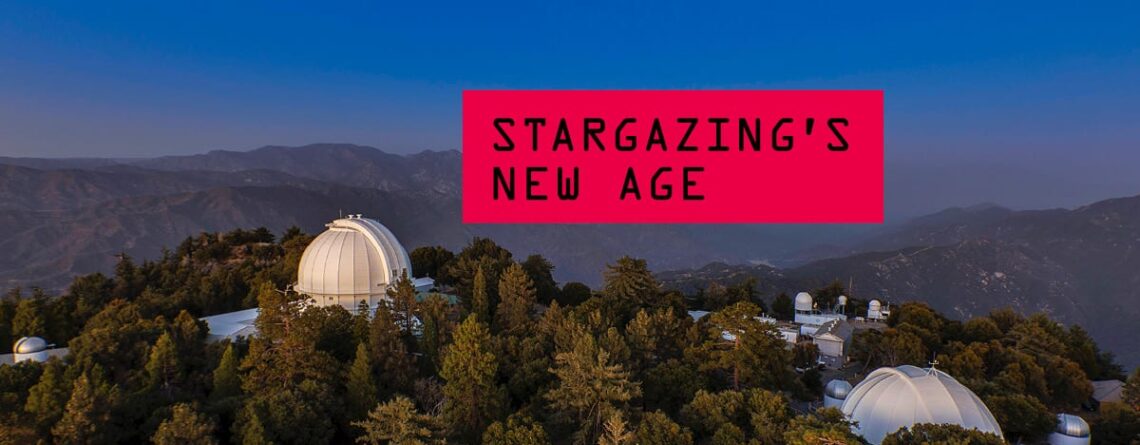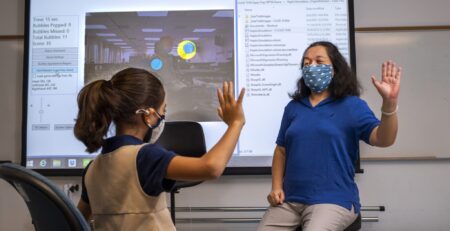Astronomy was one of the first professions to use computers. When Halley’s comet made its 1758 pass, astronomers divided up the computations required in order to determine its orbit. More than 150 years later, around the time that Georgia State was founded in 1913, Harvard astronomer William Pickering became the first to employ human “computers” — women paid low wages to sort and classify objects in glass-plate photographs.
Today, highly sensitive space telescopes such as NASA’s Solar Dynamics Observatory collect more than a terabyte (or one million million bytes) of data every day, more than any human can successfully sift through. To keep up with the data deluge, astronomers must now use complex algorithms, machine learning and immense computing power. Yet these whopping data sets are also making it possible for scientists, including researchers at Georgia State, to mine incredible new insights about life in our solar system and beyond.
Astronomy was one of the first professions to use computers. When Halley’s comet made its 1758 pass, astronomers divided up the computations required in order to determine its orbit. More than 150 years later, around the time that Georgia State was founded in 1913, Harvard astronomer William Pickering became the first to employ human “computers” — women paid low wages to sort and classify objects in glass-plate photographs.
Today, highly sensitive space telescopes such as NASA’s Solar Dynamics Observatory collect more than a terabyte (or one million million bytes) of data every day, more than any human can successfully sift through. To keep up with the data deluge, astronomers must now use complex algorithms, machine learning and immense computing power. Yet these whopping data sets are also making it possible for scientists, including researchers at Georgia State, to mine incredible new insights about life in our solar system and beyond.
How’s the Weather Up There?
How’s the Weather Up There?
As Earth’s closest star, the Sun does more than provide our planet with light and heat. The solar wind carries a constant cache of charged particles into our planet’s path, while powerful plasma explosions hurl chunks of solar material that can damage satellites, blow out electrical grids and harm astronauts.
In 1859, the largest recorded geomagnetic storm dumped enough energy into the Earth’s atmosphere to power disconnected telegraph machines and push the Northern Lights as far south as the Caribbean. A milder event in 1989 tripped the circuit breakers in Quebec’s power grid, causing a nine-hour blackout.
Concerned that massive solar storms could damage the infrastructure of the U.S., Congress recently passed the Space Weather Research and Forecasting Act, which outlines rules and responsibilities for government agencies to research, forecast and respond to solar weather events. The action was spurred in part by a 2008 report by the National Research Council, which estimated that the cost of space-weather induced outage could run as high as $2 billion during the first year alone, with recovery times running as long as a decade.
“It’s a cascading effect,” says Rafal Angryk, professor of computer science at Georgia State University.
The loss of electricity would shut down gas pumps, making it impossible for drivers to deliver food to grocery stores. Densely populated cities would be especially hard hit, says Angryk.
“Chaos would kick in,” he says. “If you have no electricity or communications, things go downhill very quickly.”
Along with astronomy professors Piet Martens and Stuart Jefferies, Angryk is working to build an interdisciplinary astroinformatics team to study space weather and space climate using big data. Their effort is funded by Georgia State’s Next Generation Program, which strengthens core and emerging research with strategic importance to the university.
Their first goal, says Martens, is to make headway in understanding and predicting the mechanisms behind solar storms. Rather than the fundamentally physics-based approach researchers have relied on in the past, they’re incorporating big data by designing algorithms — computer processes that can perform calculations and automated reasoning tasks as well as process data — to interpret the information gathered by solar telescopes.
“The more time you can give the decision-makers, the better,” Angryk says.
For instance, knowing that a flare is incoming could allow power companies in the most likely affected areas to disconnect long transmission feeds for a short time rather than take a damaging hit that could take the system offline for years.
Several thousand miles south, Jeffries is probing the solar atmosphere in Antarctica, where during certain times of year, the Sun is visible for up to 24 hours a day. Over the past three decades, Jefferies has traveled to the South Pole nine times to examine the Sun’s atmosphere at different layers, from its inner core to its outer chromosphere. The time it takes light to travel from each of those layers to the Earth helps him map the Sun’s structure and study changes in its atmosphere. The data can also be used to study the internal structure of the Sun, much like physicians use ultrasound to look inside our bodies.
Eventually, he hopes to help unravel the mystery behind the corona, an outer atmospheric layer that is enigmatically millions of degrees hotter than the Sun’s surface. Solving this puzzle could help scientists study and predict weather events such as coronal mass ejections, huge expulsions of plasma and charged particles from the corona.
Like NASA’s space telescope, Jefferies’ instrument generates lots of data. Over the course of 50 days, the telescope snaps four images every five seconds, for a total of nearly four million images over the observing run. Using an algorithm, he sorts through the wealth of images to find the best within a group. (Jefferies estimates that today he can process the same amount of data in an hour that 20 years ago would have taken four days.) This type of mass sorting can help him identify anomalies that he might not otherwise spot if he had to search through each image individually — assuming he could complete such a monumental task.
“This new approach is about extracting the best possible information,” Jefferies says. “Big data lets us get more out of the observations than we ever could before.”
POLAR TREK
Over the past three decades, professor Stuart Jefferies has traveled to the South Pole nine times to examine the Sun’s atmosphere at different layers, from its inner core to its outer chromosphere.
POLAR TREK
Over the past three decades, professor Stuart Jefferies has traveled to the South Pole nine times to examine the Sun’s atmosphere at different layers, from its inner core to its outer chromosphere.
Secrets of the Stars
Secrets of the Stars
In addition to collecting colossal amounts of information on a single star, astronomers can also use big data to study billions of stars in one swoop. These large surveys provide researchers with information about not only the locations of stars but also their sizes, ages and other characteristics.
In the past, massive stellar maps would be sketched by astronomers as they slowly slewed their telescopes across the sky or photographed on glass plates that were categorized by hand. Today, most telescopes are connected to computers, capturing digital images that have a resolution about 10 times greater than the best television screens. This granular detail allows scientists to tease out precise information that could have been easily overlooked in the past.
For the last 15 years, Distinguished University Professor Todd Henry and his team have been pulling together a grand three-dimensional map of all of the stars located (relatively) near the Sun, focusing on roughly 6,000 stellar systems. Understanding nearby stars helps place our Sun in context, he says.
“The sample has shown that the Sun is larger, hotter and more massive than 90 percent of all stars,” says Henry. “Nearby stars can also reveal what the universe is made of, and the diverse natures of the many different types of stars that make up our galaxy.”
When Henry’s team started the work in 2003, this meant taking a new dive into old data, poring through existing databases and analyzing glass plate photographs taken as far back as the 1950s to determine which stars may be closest to the Sun.
One big clue to a star’s location is its velocity. Just as a car in the next lane appears to be traveling faster than one along the horizon, stars that are speedy relative to the Sun are more likely to be our closer solar neighbors.
“If it’s moving fast, chances are it might be nearby,” Henry says.
While Henry is focused on stars near the Sun, Sebastien Lepine, professor and chair of the Department of Physics and Astronomy, is using data from the European Space Agency’s Gaia spacecraft to better understand the movement of stars. By tracking stars’ migration backward, he hopes to determine where they were born in the galaxy.
Most stars form inside stellar nurseries, dense regions of gas and dust where gravity draws individual clumps together to form collections of newborn stars. Eventually the stars separate from their siblings, but their divergent paths can provide insights into where they started out. This in turn can improve scientists’ understanding of how the Galaxy evolved and formed its various structures, such as the Milky Way’s distinctive spiral arms.
Lepine has compiled information about roughly 2.5 million stars in the Milky Way Galaxy into a catalog he calls Superblink, which combines data from different sources to create detailed profiles of stars’ motions, colors, temperatures, densities, ages and other characteristics. By studying a large population of stellar objects instead of just a handful, scientists can tease out how stars change as they age, which could provide new insight into the Sun’s past and future.
OUR EYES ON THE SKIES
Two-thousand miles from downtown Atlanta, Georgia State operates a best-in-its-class telescope that’s changing the way scientists see the stars.
The Mount Wilson Observatory sits more than 5,000 feet above Los Angeles, where the high altitude reduces atmospheric disruptions and ocean winds push away clouds to keep the sky clear. Founded in 1904, it’s where Edwin Hubble proved the universe is expanding and Nobel Laureate Albert Michelson first measured the speed of light in kilometers per second. Decades later, Georgia State began planning its own unique instrument to take advantage of the location, the Center for High Angular Resolution Astronomy — or CHARA — Array.
The CHARA Array was designed and built by a team led by Hal McAlister, a professor who was the array’s first director. (McAlister retired in 2015, and Theo ten Brummelaar is now the director of the array.) It uses a process known as optical interferometry, which incorporates signals from multiple telescopes to create a high-resolution image. Six telescopes spread across the mountain collect light, which travels through precisely placed vacuum tubes to combine at a central location. Together, the one-meter telescopes simulate a single 300-meter instrument — making CHARA the world’s most powerful optical interferometer, says Douglas Gies, Regents’ Professor of Astronomy and center director.
“If astronauts were playing frisbee on the moon,” he says, “CHARA would be able to see the frisbee.”
Using CHARA, researchers can examine the minutiae of stars, probing down to the starspots on their surface. These precise observations can help astronomers better understand the solar cycle (the Sun’s 22-year-long period of activity) and even make predictions about the strength of upcoming cycles, which can affect long-term plans for human space exploration. They can also provide insight into what to expect from the Sun as it evolves over the next 4.5 billion years.Clear California weather means CHARA is open almost every night from February until the end of December. (The instrument shuts down for maintenance during January, when the mountain tends to get snow.)
Each day, the CHARA team sets up the telescopes in the appropriate configuration for the evening viewing. While astronomers are urged to come to the mountain for their first observing session, they can communicate with the CHARA team from Atlanta or one of the five collaborating universities: the University of Michigan, the University of Sydney in Australia, the University of Exeter in the United Kingdom, and France’s l’Observatoire de la Cote d’Azur and l’Observatoire de Paris.
In 2016, scientists at CHARA also received nearly $4 million from the National Science Foundation to provide scientists around the world with greater access to the instrument. After 18 months, the research becomes part of the public database, available for anyone to use.
In addition to documenting the diversity of stellar surfaces, researchers have used CHARA to enhance observations from NASA’s Kepler Space Telescope and measure stars’ sizes. By comparing the size of a star and an orbiting exoplanet, for example, they can determine the planet’s radius, helping to unlock information about whether it’s a rocky world like ours or a gaseous giant like Jupiter.
“It’s a fantastic place to learn about the stars, their evolution and their properties,” Gies says. “It’s a real jewel of research at Georgia State.”
OUR EYES ON THE SKIES
Two-thousand miles from downtown Atlanta, Georgia State operates a best-in-its-class telescope that’s changing the way scientists see the stars.
The Mount Wilson Observatory sits more than 5,000 feet above Los Angeles, where the high altitude reduces atmospheric disruptions and ocean winds push away clouds to keep the sky clear. Founded in 1904, it’s where Edwin Hubble proved the universe is expanding and Nobel Laureate Albert Michelson first measured the speed of light in kilometers per second. Decades later, Georgia State began planning its own unique instrument to take advantage of the location, the Center for High Angular Resolution Astronomy — or CHARA — Array.
The CHARA Array was designed and built by a team led by Hal McAlister, a professor who was the array’s first director. (McAlister retired in 2015, and Theo ten Brummelaar is now the director of the array.) It uses a process known as optical interferometry, which incorporates signals from multiple telescopes to create a high-resolution image. Six telescopes spread across the mountain collect light, which travels through precisely placed vacuum tubes to combine at a central location. Together, the one-meter telescopes simulate a single 300-meter instrument — making CHARA the world’s most powerful optical interferometer, says Douglas Gies, Regents’ Professor of Astronomy and center director.
“If astronauts were playing frisbee on the moon,” he says, “CHARA would be able to see the frisbee.”
Using CHARA, researchers can examine the minutiae of stars, probing down to the starspots on their surface. These precise observations can help astronomers better understand the solar cycle (the Sun’s 22-year-long period of activity) and even make predictions about the strength of upcoming cycles, which can affect long-term plans for human space exploration. They can also provide insight into what to expect from the Sun as it evolves over the next 4.5 billion years.Clear California weather means CHARA is open almost every night from February until the end of December. (The instrument shuts down for maintenance during January, when the mountain tends to get snow.)
Each day, the CHARA team sets up the telescopes in the appropriate configuration for the evening viewing. While astronomers are urged to come to the mountain for their first observing session, they can communicate with the CHARA team from Atlanta or one of the five collaborating universities: the University of Michigan, the University of Sydney in Australia, the University of Exeter in the United Kingdom, and France’s l’Observatoire de la Cote d’Azur and l’Observatoire de Paris.
In 2016, scientists at CHARA also received nearly $4 million from the National Science Foundation to provide scientists around the world with greater access to the instrument. After 18 months, the research becomes part of the public database, available for anyone to use.
In addition to documenting the diversity of stellar surfaces, researchers have used CHARA to enhance observations from NASA’s Kepler Space Telescope and measure stars’ sizes. By comparing the size of a star and an orbiting exoplanet, for example, they can determine the planet’s radius, helping to unlock information about whether it’s a rocky world like ours or a gaseous giant like Jupiter.
“It’s a fantastic place to learn about the stars, their evolution and their properties,” Gies says. “It’s a real jewel of research at Georgia State.”
A Search for Alien Worlds
A Search for Alien Worlds
Anyone who has spotted the bright glint of Venus in the night sky knows that humans have been studying the Earth’s nearby planets for as long as we could look up. Beyond our solar neighborhood, there may be thousands more faraway worlds. But scientists still aren’t sure exactly how planets form — and to better understand them, we have to find them.
Russel White, associate professor of astronomy, is hunting for new exoplanets (planets orbiting a star outside our solar system) by analyzing thousands of young stars and looking for periodic changes in their velocities. A slight “wobble” in velocity could be caused by the gravitational pull of a planet. Demonstrating regular wobbles over time could prove the presence of a new world.
“By looking at young stars and searching for any young planets that might exist around them, we’re trying to understand how these systems come into existence and how these star systems evolve over time,” White says.
These observations could give scientists better insight into the structure of our own solar system and help them search for signs that planets orbiting other stars are potentially habitable.
Henry is also hunting for exoplanets by tracking the movements and velocities of stars, with a special emphasis on nearby stars. Surveying our nearest stellar neighbors for planets is important because their close proximity makes them ideal for more detailed follow-up observations, including a search for the presence of life.
“Our scenario of how planets formed was based on the properties of planets in our solar system,” White says. “Now that we have more planetary systems to study, and we can see that their characteristics are very different, we’re getting evidence of how dynamic and chaotic the formation process can be.”
When you study something as mind-bogglingly vast as the universe, scale is paramount. To construct accurate narratives about how a galaxy forms or a star is born, without the ability to watch these events unfold in real time, requires an expanded way of thinking. It also requires an astronomical amount of information, billions of detailed observations from which scientists can extract patterns and insights.
Today’s instruments are churning out exponentially more data about the cosmos than ever before, as each generation of telescopes is many times more powerful than the last. The sheer volume has presented a challenge: finding the signal in the noise. To make sense of all that output requires a new kind of scientist — one that can collaborate with large teams, design equipment and algorithms and dig through ever-expanding data archives.
“It goes without saying that the more information we have, the more we can potentially know,” says Jefferies. “The hard part, and the exciting part, is figuring out the best questions to ask and how to ask them. The potential that we’ll be able to discover something remarkable, something surprising, is greater than it has ever been.”
In 2013, the European Space Agency launched the Gaia spacecraft to make a census of the stars in the Milky Way. In 2018, they released results of this mission, revealing an unprecedented three-dimensional map of more than one billion stars in the Galaxy.
“Our scenario of how planets formed was based on our solar system. Now that we have more planetary systems to study, we’re getting evidence of how dynamic and chaotic the formation process can be.”
—————————————> Russel White
In 2013, the European Space Agency launched the Gaia spacecraft to make a census of the stars in the Milky Way. In 2018, they released results of this mission, revealing an unprecedented three-dimensional map of more than one billion stars in the Galaxy.
“Our scenario of how planets formed was based on our solar system. Now that we have more planetary systems to study, we’re getting evidence of how dynamic and chaotic the formation process can be.”
–––––––––––> Russel White
Photos by Trevor Traynor












Leave a Reply